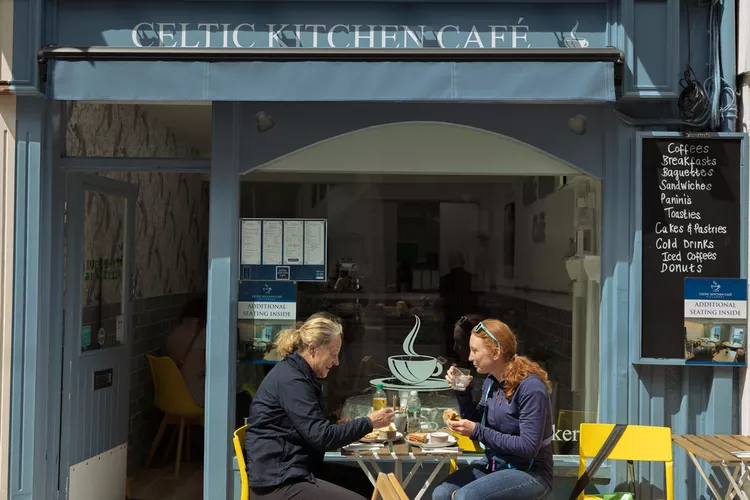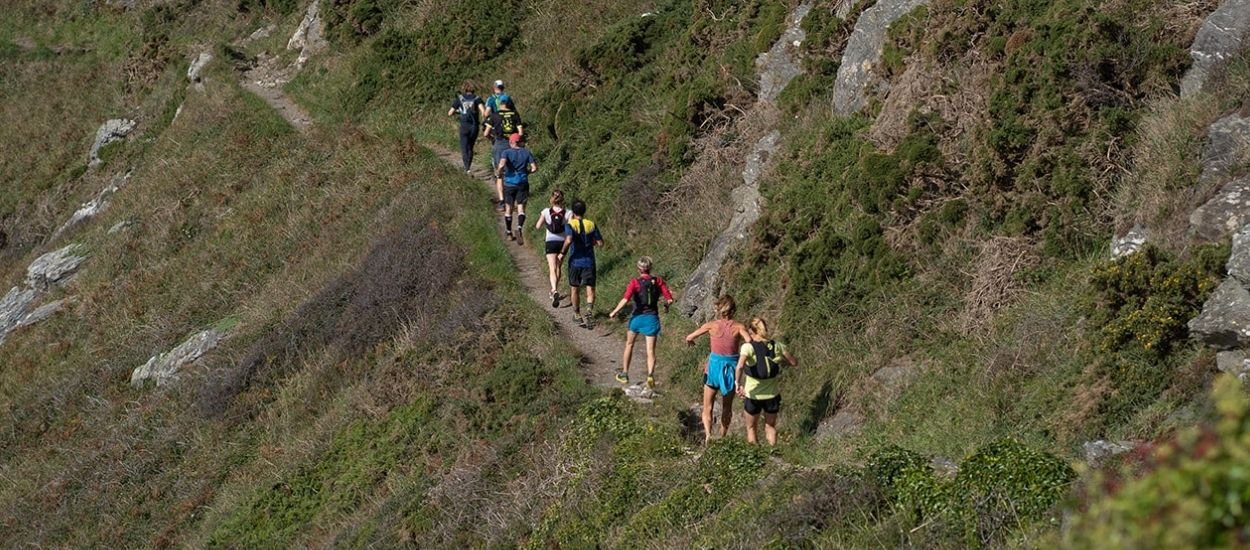
Running up a mountain is never easy—no matter how light and fun it might feel when you’re reminiscing from the cozy comfort of a couch. The same doubts always creep in: How am I still so far from the top? Does everyone struggle this much? Should I slow to a walk now so I can push to the summit later in one smooth, graceful effort? When I’m alone on the trails, these thoughts loop in my head until, suddenly, I’m at the peak, looking back at my worries like they’re miles behind me.

But as I pushed myself up the steep, rocky climb to Djouce Mountain—one of the more accessible peaks in Ireland’s Wicklow range, though still a serious challenge at 2,400 feet—I realized the usual doubts weren’t crowding my mind. Instead, I was watching the other women in my group.
Tall or petite, with cropped hair or long blond braids, they were all seasoned runners in their forties, fifties, and sixties who’d signed up for a weeklong running tour of Ireland with Run Wild Retreats. The company organizes all-women running trips everywhere from Moab and Banff to Bhutan and Peru. Our route would take us from the drier (but still boggy) east all the way to the misty southwest mountains, running for hours each day. In bright shorts and tank tops, grinning as they climbed, the group stood out against the deep green slopes dotted with heather, just about to burst into its famous purple bloom. These women made the ascent look fun—and as I listened to the steady crunch of their shoes on gravel, it was easy to fall into step with their rhythm.

At the top of Djouce, we paused for selfies, taking in what we’d just conquered. The path, lined with spiky yellow gorse, curved down toward Lough Tay—nicknamed Guinness Lake for its dark water fringed with white sand. But we weren’t done yet: we still had four miles to go. As we started downhill, one small figure darted ahead as effortlessly as water rushing down a stream. Jen Horn, an attorney, mother of three, and classically trained clarinetist, was running for the first time in a year and a half after recovering from a bad injury. She’d told us jogging down mountains was “her happy place”—and now I saw why as she navigated the rocks with ease, speeding toward the others who’d taken the flatter (and less sweaty) route below.
*Travel + Leisure Readers’ 5 Favorite Resorts in the U.K. and Ireland of 2024*
I remembered Jen’s advice about letting gravity lead—then tried it myself. It felt almost like dancing as I wove between stones, zigzagging down until I stopped near two sheep grazing peacefully in the grass. The cool wind on my face was electric. I’d borrowed Jen’s joy and let it guide me—and in doing so, my world opened up a little more.

I’ve been running for a few years, but the social side was new to me. Growing up an only child in a family that preferred indoors, the bookish daughter of two bookish professors who found the outside world too hot, cold, windy, or bright, I’d always been on my own. During the pandemic, I hiked in Colorado—but then I moved to Rome under strict lockdown, often stuck inside my neighborhood. I started running to recapture that exhausted, fulfilled feeling I got after a long trail—and to my surprise, I loved it.
Running became my time to focus on breath and body, to untangle my thoughts and wear out my worries. I loved the ache in my lungs, the feel of pavement or dirt underfoot, the ravenous hunger afterward. It was something I did just for me, always alone—partly because I had no one to join, partly because I worried I was doing it wrong, with bad form or not enough grit. But as running became routine, I wondered if it was just another habit, not an escape. Sometimes, in pouring rain or sweltering heat, I’d wish for someone to talk to, a distraction or a companion. That’s when Run Wild Retreats popped up in my search—offering trails abroad and camaraderie, plus people to share meals with at day’s end.

Haruki Murakami wrote in What I Talk About When I Talk About Running that writing honestly about running is like writing honestly about yourself. On our first day, I learned that talking about running can also reveal what’s closest to our hearts. For introductions, our lively leader Jan Curl—a fitness instructor in her sixties who went from Run Wild participant to guide—gathered us in a circle to share why we’d come. One woman told us how a rehab friend had invited her to run near the end of her recovery from alcoholism; moving her body in a new way helped silence old cravings. Others had raced competitively when younger but now ran for personal joy, not medals. Some ran to heal from illness or divorce, or returned after injuries with a gentler approach.
It was clear: there were as many reasons to run as there were runners. That’s Run Wild’s philosophy—founder Elinor Fish focuses on mindfulness over speed or endurance. A competitive trail runner herself, she noticed a different energy on women’s retreats. “Women juggle more demands,” she told me. “But we share common ground that helps us connect.”

Watching our group tackle Glendalough Valley, an hour south of Dublin in Wicklow Mountains National Park, you’d have seen a cheerful, mismatched pack, each with their own style. Climbing the Spinc Loop through woods toward a misty waterfall view, I tried keeping up with our Irish guide Nicola Cleary’s long strides to ask about racing back home. We followed an old mining road, crossing bogs on wooden boardwalks, when we spotted a herd of sika deer grazing on the hillside, their velvety antlers nodding as they ate.
But I also loved dropping back to chat with others—about college kids, office romances, relay races, marathons, ultramarathons. My favorite group? Four lively Texans from the same town near Houston. They’d raised kids together, run their first half-marathon in homemade tutus, and now traveled the world together. With their laughter and long hair, they could’ve been high school friends. Our pack was like a moving cocktail party (with electrolyte water instead of gin): we’d mix and mingle, finding the best conversation for the moment.

At the end of the Spinc Loop, we learned miners once walked this same path from Glendalough village before grueling workdays. Our reaction? Pure gratitude—instead of trudging back, we hopped a bus to cheese sandwiches and ice-cold lemonade.
After Wicklow’s unexpected heat, I craved the moody Irish mist I’d imagined. I found it at our next stop: the Falls Hotel & Spa in Ennistymon, on the west coast. I woke early to run a stunning stretch of the Wild Atlantic Way, a 1,600-mile coastal route past ancient ruins and rocky islands. At the Cliffs of Moher, thick fog made it hard to see beyond the runner ahead, the white orchids and sea pinks lining the path, or the occasional rust-colored cow nuzzling its calf.

We ran two hours out and back on a narrow dirt road, the sea roaring beside us. On the return, the fog lifted, revealing the cliffs’ edge—waves crashing below, seagulls like tiny white specks. Thrilled, we snapped photos, staying a safe distance from the drop.
How to Plan the Perfect Trip to Ireland’s Famous Cliffs of Moher
But my favorite landscape was still ahead. After a rainy stop in Lahinch—where I grabbed a goat cheese and veg sandwich on incredible focaccia at Hugo’s Bakery—we took a ferry from County Clare to Kerry, then drove south to Killarney National Park, a UNESCO Biosphere Reserve with Ireland’s only mainland red-deer herd. The Lake Hotel overlooked a dreamy view: mornings, I’d stroll by Lough Leane, spotting songbirds flitting around a ruined stone tower.

Our first Killarney run mixed the lush green of the day before with steep climbs. We jogged up the winding Gap of Dunloe road, its curves disappearing between mountains. We passed sheep dyed bright purple, orange, red, and blue—farmers’ way of tracking them across vast pastures. Occasionally, a “jaunting car” (a horse-drawn tourist carriage) squeaked by, a tradition since Queen Victoria’s 1860s visit made Irish tours fashionable.
Halfway up, drizzle turned to downpour—normally a mood-killer. Soaked, I eyed a rocky overhang for shelter, but a damp sheep and its lamb were already there, eyeing me with wary ownership. Then our guide Catriona Doolan whooped encouragement, and we rallied. Kristine Self, a Canadian ultramarathoner aiming for 10+ miles daily, tightened her windbreaker and charged uphill, inspiring us all. We sprinted to an abandoned stone hut, huddling under a tree, laughing at our first real Irish summer weather. Then we tightened our laces and pushed on—through estates and woods, logging 10 miles before reaching a cozy café for hot chocolate.

Later, at the Spa at Muckross (on an estate that hosted Queen Victoria in 1861), I soaked in a hot tub as a massage therapist worked the fatigue from my calves. At dinner in the Killarney Park hotel’s Garden Bar, we felt like victorious soldiers—even if we’d only battled the rain.
By week’s end, I’d run 50+ miles and learned I could do far more than I’d thought. But the best lessons came from the others. Kristine taught me to pack my hydration vest without sloshing. Kirstin Shrom-Rhoads, a former camp director, gave me gait tips and strengthening exercises. Others suggested races, trips, trails. Their kindness—supporting each other’s unique paths—captured the retreat’s spirit. On the bus back to Dublin, as everyone invented limericks about our adventures, I knew we’d stay in touch, swapping photos and advice long after we’d flown home.

Back at Dublin’s elegant Westbury hotel, high tea in the lobby signaled my return to civilization. In my suite, the heated marble floor soothed my feet. Sipping tea in an armchair, I scrolled through run photos—joyful figures leaping through stunning landscapes, arms raised in triumph. A cliff is just a cliff alone, but with runners along its edge, you feel the thrill, the near-danger, the victory of pushing limits.
The women’s faces, tired but radiant, reminded me I hadn’t run yet that day—though I’d passed a park begging to be explored faster than a walk. Thinking of the incredible women I’d met, I laced up my shoes and headed out.
How to Book
Run Wild Retreats leads small-group running and wellness trips worldwide for women of all ages and fitness levels. The next seven-day Ireland Trail Running & Wellness Retreat begins May 17, 2025, with stays at Wicklow Heather House, the Lake Hotel, and Falls Hotel & Spa.
Getting There
Runners fly into Dublin. The Westbury—with its plush rooms and central location off Grafton Street—is ideal for first or last nights.
